A Project of the Hudson River Estuary Program
Compiled by Tom Lake, Consulting Naturalist
Overview
So far this winter, we are not seeing a great influx of wintering bald eagles in the mid-Hudson Valley and lower estuary. Bald eagles, generally, will move south from points north and east until they find consistently open water for fish and waterfowl. This winter, much of the Hudson tidewater has provided them with a nearly ice-free carte blanche of options and opportunities.
Highlight of the Week
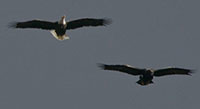 1/26 – Eastern Dutchess County: With great interest and amazement, I watched an adult golden eagle interact with an adult bald eagle high in the winter air overhead. While this may have been simply mutual curiosity, it was more likely a challenge for air space. The two eagles came together several times resulting in talon-grabs and back-rolls – the golden eagle clearly more assertive, if not the aggressor – before the bald eagle moved off. There did not seem to be a “winner,” but more of a growing lack of interest by each of them. (Photo of golden eagle and bald eagle courtesy of Mike Lemery) 1/26 – Eastern Dutchess County: With great interest and amazement, I watched an adult golden eagle interact with an adult bald eagle high in the winter air overhead. While this may have been simply mutual curiosity, it was more likely a challenge for air space. The two eagles came together several times resulting in talon-grabs and back-rolls – the golden eagle clearly more assertive, if not the aggressor – before the bald eagle moved off. There did not seem to be a “winner,” but more of a growing lack of interest by each of them. (Photo of golden eagle and bald eagle courtesy of Mike Lemery)
- Mike Lemery
[Golden eagles, in small numbers, have been frequent winter visitors to eastern Dutchess County. In contrast, bald eagles are native to the area and, in winter, their population swells with the arrival of wintering birds. The two eagle species are not likely to vie over prey, except to scavenge winter-killed white-tailed deer – golden eagles are hunters of the uplands while bald eagles are fishers of big water. Perhaps owing to the rugged terrain they travel, in general, golden eagles are a bit more assertive, some might even say aggressive. A golden eagle will never stay in the shadow of a bald eagle. In the American Southwest and Meso-America, the golden eagle is the mythical “Thunderbird!” Tom Lake]
Natural History Entries
1/23 – Manhattan, HRM 1: [A look back at a late-arrival] We bundled up against the cold today and were accompanied by colleagues who had never been with us to our research site. We checked The River Project's collection gear on the lighthouse tender Lilac moored at Pier 25 in Hudson River Park and spent some time going over protocols and methods of our sampling. While the catch in our pots and traps was minimal – isopods, amphipods, shore shrimp, sand shrimp, and mud crabs – it reflected the seasonal aquatic life under Pier 25.
-Siddhartha Hayes, Toland Kister, Anna Koskol, Helen Polanco
1/25 – Warren County, HRM 245: I've been watching the Hudson River south of The Glen, a reach of the river that is called The Ice Meadows. This is the time of the winter when the river is usually covered by frazil ice. However, at this point in late January, in the midst of what can only be called a mild winter, there is none to be seen.
- Mike Corey
[Frazil ice first forms as tiny round crystals – after nucleating in some way that has long been a puzzle to scientists – throughout the river in cold weather. Turbulent super-cooled (slightly below 32 degrees F) water tumbles the crystals around making them grow until they float at the surface in loose agglomerations. It looks like floating snow. If frazil touches something underwater, a deadfall or a rock, it sticks. It builds from the sides and from the middle of the river and can eventually form dams. Such is the case at the Ice Meadows where the ice can grow to near glacial proportions. Cobbles and gravels at the bottom can be popped to the surface when the ice becomes buoyant enough. This process adds to the other river dynamics that are constantly moving sand, silt, gravel, and cobbles along the riverbed. Evelyn Greene]
*** Fish of the Week ***
 1/25 – Hudson River Watershed: Fish-of-the-Week for Week 56 is the spottail shiner (Notropis hudsonius), number 54 (of 230) on our watershed list of fishes. If you would like a copy of our list, e-mail - trlake7@aol.com. (Photo of spottail shiner courtesy of Tom Lake) 1/25 – Hudson River Watershed: Fish-of-the-Week for Week 56 is the spottail shiner (Notropis hudsonius), number 54 (of 230) on our watershed list of fishes. If you would like a copy of our list, e-mail - trlake7@aol.com. (Photo of spottail shiner courtesy of Tom Lake)
[The spottail shiner, a native Hudson River fish, is one of 34 species of carps and minnows (Cyprinidae) the largest family of fishes in the watershed. Notropis hudsonius was described to science by DeWitt Clinton in 1824, between his two terms as the sixth governor of New York State (1817-1822, 1825-1828).
Clinton's very detailed description of the fish was submitted to the forerunner of the International Commission on Zoological Nomenclature in 1824 with a proposed name of Clupea hudsonius. (Clupea is Latin for herring-like fish.) Over the next 69 years, other scientific names were offered with varying morphological evidence for change, but ichthyologists settled on Notropis hudsonius. The spottail type site location is the Hudson River, making the species the true Hudson River fish. However, the type specimen (by which others are systemically compared) was lost in 1866 when a fire destroyed the Lyceum of Natural History (now The New York Academy of Sciences), in Manhattan.
Spottail shiner is found across a wide swath of North America from far west Canada southeast through the American Midwest, the Great Lakes, through our area, and then south along the coast to Georgia. They are common throughout our watershed from ponds, lakes, reservoirs, and rivers, even venturing into the tidal brackish water of the lower estuary.
- Tom Lake]
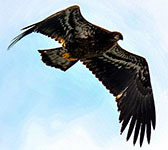 1/25 – Town of Chatham, HRM 128: In late afternoon, as winds became very blustery, I was thrilled to see four immature bald eagles fishing in Kinderhook Creek at Malden Bridge. Soon, they lapsed into wildly swooping and chasing each other on the strong updrafts. After a half-hour of daredevil tag, two soared high into the sky in a spiral and then latched talons. They plummeted downward, cartwheeling until they broke apart only fifty feet above the wet ice. The other two circled them, and then they all flew off to the east in a strong gust of wind. (Photo of immature bald eagle courtesy of Deborah Tracy Kral) 1/25 – Town of Chatham, HRM 128: In late afternoon, as winds became very blustery, I was thrilled to see four immature bald eagles fishing in Kinderhook Creek at Malden Bridge. Soon, they lapsed into wildly swooping and chasing each other on the strong updrafts. After a half-hour of daredevil tag, two soared high into the sky in a spiral and then latched talons. They plummeted downward, cartwheeling until they broke apart only fifty feet above the wet ice. The other two circled them, and then they all flew off to the east in a strong gust of wind. (Photo of immature bald eagle courtesy of Deborah Tracy Kral)
- Kathryn Conway
[These immatures demonstrated two typical bald eagle-behaviors:
(1) The “game-of-tag” is a quite common event that seems to be more prevalent in winter when scores of wintering eagles visit. It is more of a game played by immatures (adults seem far too "mature"). Usually, two or more immatures gather, and one selects a “keep-away” object, such as a fish, stick, conifer cone, clam, stone, or even a chunk of ice. The holder of the object flies away, and the others follow in hot pursuit. At some point, they overtake the “keeper” and the object is dropped, only to be scooped up by another, and the game goes on. It is thought that this game is practice for the day when, as adults, they will begin pirating fish from osprey.
(2) Kathryn’s description of the talon-locking and free-fall is another common behavior practiced in earnest by adults. On a Valentine's Day dawn at New Hamburg a while ago, I watched a pair of adult bald eagles perform a mating ritual, shadowing each other over the ice with loop-de-loops and wing-touches. At the apex of a long arc in the sky, they locked talons – one turned on its back in the air, the other mirrored it from above– and they went into a free-fall for more than a hundred feet before releasing and flaring out over the ice. At the climax of each acrobatic move, they fell away in synchronized flight – flap-flap-glide – both wheeling and banking away in perfect form. It was like an exquisite ballet performance. At times, they flew so close to each other that they cast only one shadow, drifting across the limestone face of Cedarcliff. Their effortless yet powerful wing beats moved them through the air as a single bird, communicating more through instinct than any utterance. Tom Lake]
 1/26 – Town of Knox, HRM 145: “Springtails” were out in full force today. Their emergence is an annual event, but the sheer numbers this year were the most dramatic I have ever seen. (Photo of springtail courtesy of Tom Murray) 1/26 – Town of Knox, HRM 145: “Springtails” were out in full force today. Their emergence is an annual event, but the sheer numbers this year were the most dramatic I have ever seen. (Photo of springtail courtesy of Tom Murray)
- Dave Nelson
[“Snow fleas,” (Hypogastrura nivicola), or springtails, are frequently seen on the snow in winter. They are not insects (Class Insecta), but rather springtails (Class Collembola). Springtails have a little forked tail (furcula) that they fold under their body and use to spring up many times their body length (thus, “springtails”). Their bodies contain a protein that acts as a natural antifreeze allowing them to appear on top of the snow where they’re easy to spot on warm days. Jerry Carlson adds, “I’ve always been told they move onto the snow when it gets too wet for them below, as snow-melt waters collect and flow on frozen soil. Sometimes they are scattered like pepper sprinkles; other times they are aggregated in long narrow “soldier” columns, marching to somewhere.” Tom Lake]
1/26 – Millbrook, HRM 82: We came upon a mixed flock of blackbirds this morning that we estimated numbered near 10,000 just off Route 343. Among them were common grackles, starlings, brown-headed cowbirds, red-winged blackbirds, and rusty blackbirds.
- Debbie van Zyl, Barbara Mansell (Ralph T. Waterman Bird Club)
1/27 – Southern Dutchess County: Adult green herons arrived at a small island in the middle of our small five-acre lake last April 21, 2019 and I began studying them. I noted the first nest building on April 25 on a small island in the center of the lake. The first two fluffy chicks showed up on June 9th. By the end of June, we had counted more than 20 adults and at least 12 fledglings. That number of green herons is definitely notable for Dutchess County. We have had a few green herons nesting on the island in previous years, but in 2019 we consistently counted more than twenty at one time. Through a scope today, we were able to count seven nests on the island. Our comment last summer, considering the number of both adults and fledglings, was that this could be a green heron rookery, but we would not know for sure until next spring. This year will be the next spring!
- Laura Facchin, Barbara Mansell, Maha Katnani, Barbara Butler (Ralph T. Waterman Bird Club)
1/28 – Milan, HRM 90: Three purple finches, one male, two females, were alone on the sunflower feeders near midday. Purple finches have been very infrequent visitors, maybe only six so far this winter.
- Frank Margiotta (Ralph T. Waterman Bird Club)
[No purple finches were reported for the Ralph T. Waterman 2019 Christmas Bird Count. In fact, the last time they were noted for a CBC was 2015. Frank Margiotta]
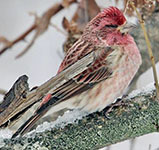 1/28 – Town of Wappinger, HRM 67: I was watching the seed feeders that were crowded with goldfinches when a different and surprising finch suddenly arrived. It was a gorgeous purple finch, something we see maybe once or twice a winter, but this one was my first ever. (Photo of purple finch courtesy of Deborah Tracy Kral) 1/28 – Town of Wappinger, HRM 67: I was watching the seed feeders that were crowded with goldfinches when a different and surprising finch suddenly arrived. It was a gorgeous purple finch, something we see maybe once or twice a winter, but this one was my first ever. (Photo of purple finch courtesy of Deborah Tracy Kral)
- B.J. Jackson
[Roger Tory Peterson (1980) has one of the most classic descriptions for the purple finch, commenting that it looked like “a sparrow dipped in raspberry sauce.” Tom Lake]
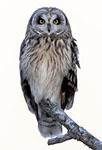 1/28 – Galeville, HRM 74: The short-eared owls were late in getting up and out to hunt the grasslands during a just-before-sunset visit to the Shawangunks Grasslands National Wildlife Refuge. The light was fading, but they flew in nice and close. The owls seemed to be primarily catching meadow voles (Microtus pennsylvanicus) in the grasslands (I’ve taken some photos of short-eared owls with meadow voles.) (Photo of short-eared owl courtesy of Debbie Quick) 1/28 – Galeville, HRM 74: The short-eared owls were late in getting up and out to hunt the grasslands during a just-before-sunset visit to the Shawangunks Grasslands National Wildlife Refuge. The light was fading, but they flew in nice and close. The owls seemed to be primarily catching meadow voles (Microtus pennsylvanicus) in the grasslands (I’ve taken some photos of short-eared owls with meadow voles.) (Photo of short-eared owl courtesy of Debbie Quick)
- Debbie Quick
1/29 – Newcomb, HRM 300: The river was mostly frozen in the typical backwater areas, but it has been a roller coaster winter: the river will freeze over and then open up. We have had plenty of ice on the lakes and enough snow cover for the snowmobiles to get out and about, but the conditions are far from ideal.
- Dave Olbert
[Dave and Ruth Olbert of Newcomb, river mile 300 near the Adirondack headwaters, are one of the original Hudson River Almanac contributors. Their first entry came 25 years ago.
Tom Lake]
 1/30 – Wappinger Creek, HR 67.5: Bald eagle nest NY459 has epitomized the rush to readiness for Hudson River Valley bald eagle nests. From above tidewater south to the lower estuary, eagle pairs were refurbishing their nests. Early this morning, both adults had just finished some stick-and-branch delivery and were now perched together on a branch next to the nest seemingly contented. Perhaps they had already eaten as they ignored the brilliant drake common merganser swimming 100 feet below in the tidewater of Wappinger Creek. (Photo of common merganser courtesy of Mauricette Potthast) 1/30 – Wappinger Creek, HR 67.5: Bald eagle nest NY459 has epitomized the rush to readiness for Hudson River Valley bald eagle nests. From above tidewater south to the lower estuary, eagle pairs were refurbishing their nests. Early this morning, both adults had just finished some stick-and-branch delivery and were now perched together on a branch next to the nest seemingly contented. Perhaps they had already eaten as they ignored the brilliant drake common merganser swimming 100 feet below in the tidewater of Wappinger Creek. (Photo of common merganser courtesy of Mauricette Potthast)
- Tom Lake, T.R. Jackson
[In most years, the beginning of the mating season would be no more than two weeks away. The adults might be encouraged by the mild winter weather to start earlier. However, their mating and incubation season does not occur in a vacuum; the timing of eagle hatchling emergence is tied to eons of other natural rhythms, such ice-out and the arrival of fish from the sea. Tom Lake]
1/30 – Manhattan, HRM 1: We checked The River Project's collection gear on the lighthouse tender Lilac moored at Pier 25 in Hudson River Park. We caught isopods, amphipods, grass shrimp, and a few mud crabs. We are still making fish wishes for the first fish of 2020 at our site!
- Toland Kister, Olivia Radick, Siddhartha Hayes
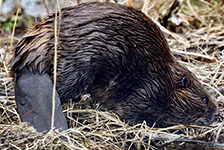 1/31 – Newcomb, HRM 300: The Hudson River spreads out a bit downstream after flowing past our home and under Route 28N. Often, the quieter backwater areas have become iced-over. While we occasionally spot a river otter on the ice, recently we have seen a beaver, a far more unusual sighting in the middle of winter. (Photo of beaver courtesy of Deborah Tracy Kral) 1/31 – Newcomb, HRM 300: The Hudson River spreads out a bit downstream after flowing past our home and under Route 28N. Often, the quieter backwater areas have become iced-over. While we occasionally spot a river otter on the ice, recently we have seen a beaver, a far more unusual sighting in the middle of winter. (Photo of beaver courtesy of Deborah Tracy Kral)
- Dave Olbert
1/31 – Town of Wappinger, HRM 68: This was Day 16 of our extraordinary winter visitor, a gorgeous female summer tanager (Piranga rubra). The rare visitor was first sighted and photographed on January 15.
- Melissa Fischer, Stephen Fischer (R.T. Waterman Bird Club)
[For Dutchess County, there were only three previous records of a summer tanager (1962, 1988, 2008). Roger Tory Peterson’s Field Guide to the Birds (1980) depicts the summer tanager’s breeding range from the Gulf Coast north to southern Pennsylvania and New Jersey. However, Since the 1940s, summer tanagers have been very slowly expanding north. Stan Deorsey]
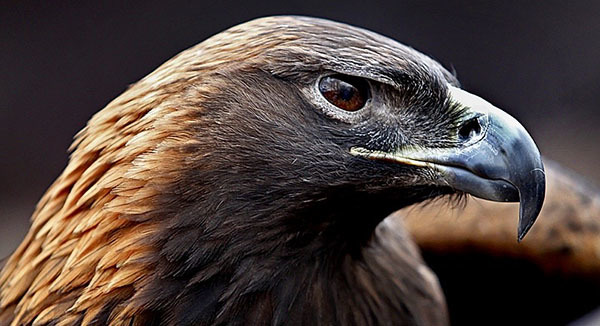
Hudson River Miles
The Hudson is measured north from Hudson River Mile 0 at the Battery at the southern tip of Manhattan. The George Washington Bridge is at HRM 12, the Tappan Zee 28, Bear Mountain 47, Beacon-Newburgh 62, Mid-Hudson 75, Kingston-Rhinecliff 95, Rip Van Winkle 114, and the Federal Dam at Troy, the head of tidewater, at 153. The tidal section of the Hudson constitutes a bit less than half the total distance – 315 miles – from Lake Tear of the Clouds to the Battery. Entries from points east and west in the watershed reference the corresponding river mile on the mainstem.
To Contribute Your Observations or to Subscribe
The Hudson River Almanac is compiled and edited by Tom Lake and emailed weekly by DEC's Hudson River Estuary Program. Share your observations by e-mailing them to trlake7@aol.com.
To subscribe to the Almanac (or to unsubscribe), use the links on DEC's Hudson River Almanac or DEC Delivers web pages.
Discover New York State Conservationist - the award-winning, advertisement-free magazine focusing on New York State's great outdoors and natural resources. Conservationist features stunning photography, informative articles and around-the-state coverage. Visit the Conservationist webpage for more information.
Useful Links
National Oceanic and Atmospheric Administration online tide and tidal current predictions are invaluable when planning Hudson River field trips.
For real-time information on Hudson River tides, weather and water conditions from sixteen monitoring stations, visit the Hudson River Environmental Conditions Observing System website.
DEC's Smartphone app for iPhone and Android is now available at: New York Fishing, Hunting & Wildlife App.
Adventure NY
Under Governor Cuomo's Adventure NY initiative, DEC is making strategic investments to expand access to healthy, active outdoor recreation, connect more New Yorkers and visitors to nature and the outdoors, protect natural resources, and boost local economies. This initiative will support the completion of more than 75 projects over the next three years, ranging from improvements to youth camps and environmental education centers to new boat launches, duck blinds, and hiking trails. Read more about the Adventure NY initiative. For more information on planning an outdoor adventure in New York State, visit DEC's website at http://www.dec.ny.gov/outdoor.
Information about the Hudson River Estuary Program is available on DEC's website at http://www.dec.ny.gov/lands/4920.html.
|


 1/26 – Eastern Dutchess County: With great interest and amazement, I watched an adult golden eagle interact with an adult bald eagle high in the winter air overhead. While this may have been simply mutual curiosity, it was more likely a challenge for air space. The two eagles came together several times resulting in talon-grabs and back-rolls – the golden eagle clearly more assertive, if not the aggressor – before the bald eagle moved off. There did not seem to be a “winner,” but more of a growing lack of interest by each of them. (Photo of golden eagle and bald eagle courtesy of Mike Lemery)
1/26 – Eastern Dutchess County: With great interest and amazement, I watched an adult golden eagle interact with an adult bald eagle high in the winter air overhead. While this may have been simply mutual curiosity, it was more likely a challenge for air space. The two eagles came together several times resulting in talon-grabs and back-rolls – the golden eagle clearly more assertive, if not the aggressor – before the bald eagle moved off. There did not seem to be a “winner,” but more of a growing lack of interest by each of them. (Photo of golden eagle and bald eagle courtesy of Mike Lemery) 1/25 – Hudson River Watershed: Fish-of-the-Week for Week 56 is the spottail shiner (Notropis hudsonius), number 54 (of 230) on our watershed list of fishes. If you would like a copy of our list, e-mail -
1/25 – Hudson River Watershed: Fish-of-the-Week for Week 56 is the spottail shiner (Notropis hudsonius), number 54 (of 230) on our watershed list of fishes. If you would like a copy of our list, e-mail -  1/25 – Town of Chatham, HRM 128: In late afternoon, as winds became very blustery, I was thrilled to see four immature bald eagles fishing in Kinderhook Creek at Malden Bridge. Soon, they lapsed into wildly swooping and chasing each other on the strong updrafts. After a half-hour of daredevil tag, two soared high into the sky in a spiral and then latched talons. They plummeted downward, cartwheeling until they broke apart only fifty feet above the wet ice. The other two circled them, and then they all flew off to the east in a strong gust of wind. (Photo of immature bald eagle courtesy of Deborah Tracy Kral)
1/25 – Town of Chatham, HRM 128: In late afternoon, as winds became very blustery, I was thrilled to see four immature bald eagles fishing in Kinderhook Creek at Malden Bridge. Soon, they lapsed into wildly swooping and chasing each other on the strong updrafts. After a half-hour of daredevil tag, two soared high into the sky in a spiral and then latched talons. They plummeted downward, cartwheeling until they broke apart only fifty feet above the wet ice. The other two circled them, and then they all flew off to the east in a strong gust of wind. (Photo of immature bald eagle courtesy of Deborah Tracy Kral) 1/26 – Town of Knox, HRM 145: “Springtails” were out in full force today. Their emergence is an annual event, but the sheer numbers this year were the most dramatic I have ever seen. (Photo of springtail courtesy of Tom Murray)
1/26 – Town of Knox, HRM 145: “Springtails” were out in full force today. Their emergence is an annual event, but the sheer numbers this year were the most dramatic I have ever seen. (Photo of springtail courtesy of Tom Murray) 1/28 – Town of Wappinger, HRM 67: I was watching the seed feeders that were crowded with goldfinches when a different and surprising finch suddenly arrived. It was a gorgeous purple finch, something we see maybe once or twice a winter, but this one was my first ever. (Photo of purple finch courtesy of Deborah Tracy Kral)
1/28 – Town of Wappinger, HRM 67: I was watching the seed feeders that were crowded with goldfinches when a different and surprising finch suddenly arrived. It was a gorgeous purple finch, something we see maybe once or twice a winter, but this one was my first ever. (Photo of purple finch courtesy of Deborah Tracy Kral) 1/28 – Galeville, HRM 74: The short-eared owls were late in getting up and out to hunt the grasslands during a just-before-sunset visit to the Shawangunks Grasslands National Wildlife Refuge. The light was fading, but they flew in nice and close. The owls seemed to be primarily catching meadow voles (Microtus pennsylvanicus) in the grasslands (I’ve taken some photos of short-eared owls with meadow voles.) (Photo of short-eared owl courtesy of Debbie Quick)
1/28 – Galeville, HRM 74: The short-eared owls were late in getting up and out to hunt the grasslands during a just-before-sunset visit to the Shawangunks Grasslands National Wildlife Refuge. The light was fading, but they flew in nice and close. The owls seemed to be primarily catching meadow voles (Microtus pennsylvanicus) in the grasslands (I’ve taken some photos of short-eared owls with meadow voles.) (Photo of short-eared owl courtesy of Debbie Quick) 1/30 – Wappinger Creek, HR 67.5: Bald eagle nest NY459 has epitomized the rush to readiness for Hudson River Valley bald eagle nests. From above tidewater south to the lower estuary, eagle pairs were refurbishing their nests. Early this morning, both adults had just finished some stick-and-branch delivery and were now perched together on a branch next to the nest seemingly contented. Perhaps they had already eaten as they ignored the brilliant drake common merganser swimming 100 feet below in the tidewater of Wappinger Creek. (Photo of common merganser courtesy of Mauricette Potthast)
1/30 – Wappinger Creek, HR 67.5: Bald eagle nest NY459 has epitomized the rush to readiness for Hudson River Valley bald eagle nests. From above tidewater south to the lower estuary, eagle pairs were refurbishing their nests. Early this morning, both adults had just finished some stick-and-branch delivery and were now perched together on a branch next to the nest seemingly contented. Perhaps they had already eaten as they ignored the brilliant drake common merganser swimming 100 feet below in the tidewater of Wappinger Creek. (Photo of common merganser courtesy of Mauricette Potthast) 1/31 – Newcomb, HRM 300: The Hudson River spreads out a bit downstream after flowing past our home and under Route 28N. Often, the quieter backwater areas have become iced-over. While we occasionally spot a river otter on the ice, recently we have seen a beaver, a far more unusual sighting in the middle of winter. (Photo of beaver courtesy of Deborah Tracy Kral)
1/31 – Newcomb, HRM 300: The Hudson River spreads out a bit downstream after flowing past our home and under Route 28N. Often, the quieter backwater areas have become iced-over. While we occasionally spot a river otter on the ice, recently we have seen a beaver, a far more unusual sighting in the middle of winter. (Photo of beaver courtesy of Deborah Tracy Kral)